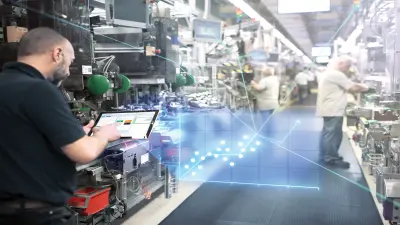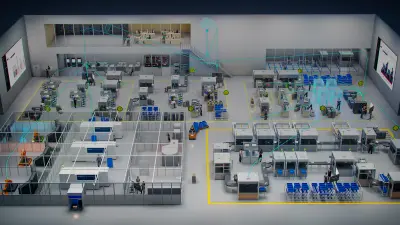Giving production a facelift
A research project is developing the underlying software for automotive industry

Faster, more flexible, and more efficient: these characteristics are the automotive industry’s main demands when it comes to developing its own production systems. To achieve this, today’s manufacturing operations need to be put on a new technological footing. This is exactly what the participants in the SDM4FZI research project (Software-Defined Manufacturing for the Vehicle and Supplier Industry) have set out to do. Led by Bosch, the University of Stuttgart, and the Karlsruhe Institute of Technology (KIT), a total of thirty companies will define the foundations for software-defined manufacturing over the next three years. Their goal is to design software that can flexibly plan, manage, and modify everything from individual components to entire factories. In the automotive industry, this will pave the way for more variants and faster model and product changes. It will also improve competitiveness. The German Federal Ministry for Economic Affairs and Energy is funding the research project to the tune of some 35 million euros.
Rigid systems hold vehicle production back

Today, it often takes months, and sometimes years, for the technical elements of the manufacturing chain for a new model to be put in place, from supplier to final assembly. Together with the considerable economic cost involved, this stymies rapid market launches. The root cause of this is that many machines are designed and built specifically for one single new product. The software is usually inextricably coupled to particular machinery and products and is not transferable to other processes. SDM4FZI now aims to create a uniform framework for factories that will enable new products to be manufactured in existing operating environments without major retooling times. “By linking various Industry 4.0 approaches, we are getting one step closer to adaptable manufacturing,” says the Bosch Research project manager Matthias Meier. “An ecosystem for software-defined manufacturing allows us to bring the benefits of cloud technology to production. Software makes it possible to use automation technology and IT systems for individual, specific applications without having to build the hardware from scratch.”
Uniform framework enables flexible manufacturing
The project partners are developing prototypes for machinery and production lines that are largely defined by software. Such prototypes are based on digital twins, which make it possible to plan, build, and test production systems virtually. This conserves resources and saves on energy and costs. During production, moreover, it also makes the individual manufacturing stages more versatile, so they can be adapted more quickly to new market conditions. Thanks to the digital twins, companies can prepare and implement improvements, and also use AI to analyze them, without having to interrupt the production process. The main focus of the research alliance’s project is on making automation technology, machinery, and systems more flexible in order to boost efficiency in the production of supplier components and vehicles.

New opportunities for the vehicle industry
By pooling expertise from automation, mechanical engineering, IT, and the automotive industry, the consortium aims to create a common understanding of the requirements and to develop interoperable solutions. “The large number of project partners demonstrates how substantial a role software plays in the manufacturing of tomorrow,” says Michael Neubauer, chief technology officer for ISW at the University of Stuttgart. “We are working on pioneering approaches that will improve German companies’ competitiveness.” For example, the project partners are drafting a guide for the selection and use of suitable technologies, as well as standards for building software-defined factories.